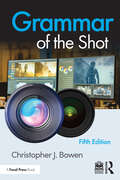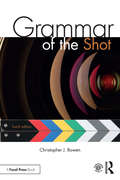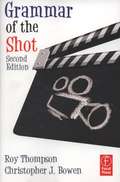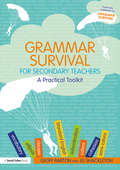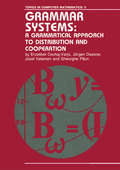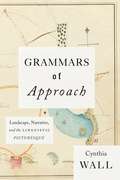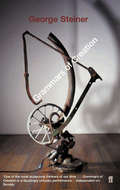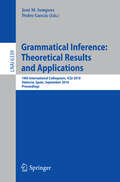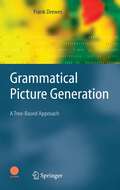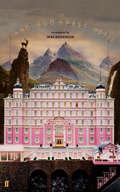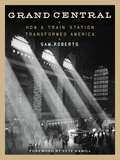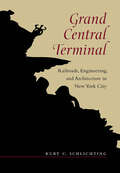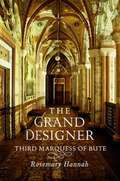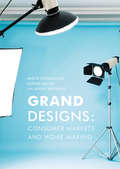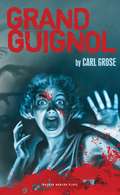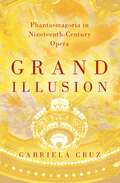- Table View
- List View
Grammar of the Shot
by Christopher J. BowenThe newly revised and updated fifth edition of Grammar of the Shot teaches readers theoretical principles behind successful visual communication in motion media through discussions of shot composition, depth cues, lens choices, lighting, screen direction, camera movement, and shooting for editing. Many general practices are outlined that will help readers create rich, multi-layered visuals. Designed as an easy-to-use reference, this book presents each topic succinctly with clear photographs and diagrams illustrating key concepts, practical exercises, and quiz questions, and is a staple of any filmmaker’s library. New to the fifth edition: Instructional and student resources offer downloadable and editable raw footage so that students can practice the techniques described in the book, and instructional videos showcasing examples of different editing choices and types of shot transitions. Thorough chapter content reviews and refreshed exercises and quizzes help test readers on their knowledge using real-world scenarios. New sections, Principles in Practice (PIPs), concludes each chapter by presenting unique scenarios that a video maker may encounter in their own video-editing work and offers creative solutions and advice on how one might handle them. Together with its companion volume, Grammar of the Edit, the core concepts discussed in these books offer concise and practical resources for both experienced and aspiring filmmakers.
Grammar of the Shot
by Christopher J. BowenThe newly revised and updated fifth edition of Grammar of the Shot teaches readers theoretical principles behind successful visual communication in motion media through discussions of shot composition, depth cues, lens choices, lighting, screen direction, camera movement, and shooting for editing. Many general practices are outlined that will help readers create rich, multi-layered visuals. Designed as an easy-to-use reference, this book presents each topic succinctly with clear photographs and diagrams illustrating key concepts, practical exercises, and quiz questions, and is a staple of any filmmaker’s library. New to the fifth edition: Instructional and student resources offer downloadable and editable raw footage so that students can practice the techniques described in the book, and instructional videos showcasing examples of different editing choices and types of shot transitions. Thorough chapter content reviews and refreshed exercises and quizzes help test readers on their knowledge using real-world scenarios. New sections, Principles in Practice (PIPs), concludes each chapter by presenting unique scenarios that a video maker may encounter in their own video-editing work and offers creative solutions and advice on how one might handle them. Together with its companion volume, Grammar of the Edit, the core concepts discussed in these books offer concise and practical resources for both experienced and aspiring filmmakers.
Grammar of the Shot
by Roy Thompson Christopher J. BowenThe newly-revised and updated fourth edition of Grammar of the Shot teaches readers the principles behind successful visual communication in motion media through shot composition, screen direction, depth cues, lighting, camera movement, and shooting for editing. Many general practices are suggested that should help to create rich, multi-layered visuals. Designed as an easy-to-use reference, Grammar of the Shot presents each topic succinctly with clear photographs and diagrams illustrating key concepts, practical exercises, and quiz questions, and is a staple of any filmmaker’s library. New to the fourth edition: an expanded companion website at www.routledge.com/cw/Bowen, offering downloadable scenes and editable raw footage so that students can practice the techniques described in the book, and instructional videos showcasing examples of different compositional choices; new and expanded quiz questions and practical exercises at the end of each chapter to help test readers on their knowledge using real-world scenarios; updated topic discussions, explanations, illustrations, and visual examples. Together with its companion volume, Grammar of the Edit, the core concepts discussed in these books offer concise and practical resources for both experienced and aspiring filmmakers.
Grammar of the Shot (PDF)
by Roy Thompson Christopher J. BowenPeople 'read' pictures as they do words, and pictures, like sentences, have their own grammar. A picture maker must be able to use the grammar correctly so that the visual story to be told will be clear and easily understood by all the audience. Grammar of the Shot is a manual for novice shooters (or anyone who needs a refresher) on the basic principles of putting together a coherent film or video piece, shot by shot. This book describes in no uncertain terms what absolutely must be in every shot--so that the successful film-maker can build a story that flows smoothly. It's designed as an easy-to-use reference, with each topic covered succinctly and accompanied by clear photographs and diagrams. Simple, elegant, and easy to use, Grammar of the Shot is a staple of the filmmaker's library.
Grammar of the Shot
by Roy Thompson Christopher J. BowenThe newly-revised and updated fourth edition of Grammar of the Shot teaches readers the principles behind successful visual communication in motion media through shot composition, screen direction, depth cues, lighting, camera movement, and shooting for editing. Many general practices are suggested that should help to create rich, multi-layered visuals. Designed as an easy-to-use reference, Grammar of the Shot presents each topic succinctly with clear photographs and diagrams illustrating key concepts, practical exercises, and quiz questions, and is a staple of any filmmaker’s library. New to the fourth edition: an expanded companion website at www.routledge.com/cw/Bowen, offering downloadable scenes and editable raw footage so that students can practice the techniques described in the book, and instructional videos showcasing examples of different compositional choices; new and expanded quiz questions and practical exercises at the end of each chapter to help test readers on their knowledge using real-world scenarios; updated topic discussions, explanations, illustrations, and visual examples. Together with its companion volume, Grammar of the Edit, the core concepts discussed in these books offer concise and practical resources for both experienced and aspiring filmmakers.
Grammar Survival for Secondary Teachers: A Practical Toolkit
by Geoff Barton Jo ShackletonThis third edition of Grammar Survival brings the content fully up-to-date with the new National Curriculum and GCSEs, making it current and relevant for all secondary school English teachers. Grammar Survival for Secondary Teachers combines knowledge about grammar with pedagogical approaches. Each left-hand page sets out the knowledge teachers need about different aspects of grammar, incorporating research evidence where appropriate, and each right-hand page offers practical ideas and methods for teaching it, often in the context of authentic texts to show grammar in action. This book aims to help pupils become more confident readers and writers, able to make conscious and informed choices about the use of grammar, vocabulary and punctuation in their own work. Chapters cover the following: Vocabulary Extending knowledge about grammar Punctuation Levels of formality Grammar for reading and writing Writing about language use Full glossary and further reading recommendations Completely underpinned by the National Curriculum Programmes of Study for Key Stages 3 and 4, this book supports all secondary school English teachers, regardless of their chosen GCSE specification, and is essential reading for trainee, newly qualified and experienced teachers alike.
Grammar Survival for Secondary Teachers: A Practical Toolkit
by Geoff Barton Jo ShackletonThis third edition of Grammar Survival brings the content fully up-to-date with the new National Curriculum and GCSEs, making it current and relevant for all secondary school English teachers. Grammar Survival for Secondary Teachers combines knowledge about grammar with pedagogical approaches. Each left-hand page sets out the knowledge teachers need about different aspects of grammar, incorporating research evidence where appropriate, and each right-hand page offers practical ideas and methods for teaching it, often in the context of authentic texts to show grammar in action. This book aims to help pupils become more confident readers and writers, able to make conscious and informed choices about the use of grammar, vocabulary and punctuation in their own work. Chapters cover the following: Vocabulary Extending knowledge about grammar Punctuation Levels of formality Grammar for reading and writing Writing about language use Full glossary and further reading recommendations Completely underpinned by the National Curriculum Programmes of Study for Key Stages 3 and 4, this book supports all secondary school English teachers, regardless of their chosen GCSE specification, and is essential reading for trainee, newly qualified and experienced teachers alike.
Grammar Systems: A Grammatical Approach to Distribution and Cooperation
by Erzsebet Csuhaj-Varju Jurgen Dassow Jozef Kelemen Gheorghe PaunFirst Published in 1994. The central problem of the “classic” formal language theory concerns the generation (the recognition) of languages by grammars (automata, respectively). However, in present day computer science, in artificial intelligence, in cognitive psychology and in other related fields we have to deal more and more with complex tasks distributed among a set of “ processors” , which are working together in a well defined way. Parallel computers, computer nets, distributed data bases and knowledge sources are practical materializations of this idea. Similarly, the psychologists speak about the modularity of mind, in problem solving theories there appear many models based on cognitive agents’ cooperation. As the formal language theory is involved in most of these circumstances (for example, as a theoretical framework, well developed from a mathematical point of view, for modelling aspects whose essence can be captured at the level of symbol systems, of the syntax of collections of strings of abstract symbols), a clear challenge appears for it: to consider systems o f grammars/automata, working together for generating/recognizing a language. In this context, notions such as distribution, cooperation, communication, concurrency, synchronization, parallelism etc. should be formalized and enlightened. The present monograph is an attempt to answer this challenge.
Grammar Systems: A Grammatical Approach to Distribution and Cooperation
by Erzsebet Csuhaj-Varju Jurgen Dassow Jozef Kelemen Gheorghe PaunFirst Published in 1994. The central problem of the “classic” formal language theory concerns the generation (the recognition) of languages by grammars (automata, respectively). However, in present day computer science, in artificial intelligence, in cognitive psychology and in other related fields we have to deal more and more with complex tasks distributed among a set of “ processors” , which are working together in a well defined way. Parallel computers, computer nets, distributed data bases and knowledge sources are practical materializations of this idea. Similarly, the psychologists speak about the modularity of mind, in problem solving theories there appear many models based on cognitive agents’ cooperation. As the formal language theory is involved in most of these circumstances (for example, as a theoretical framework, well developed from a mathematical point of view, for modelling aspects whose essence can be captured at the level of symbol systems, of the syntax of collections of strings of abstract symbols), a clear challenge appears for it: to consider systems o f grammars/automata, working together for generating/recognizing a language. In this context, notions such as distribution, cooperation, communication, concurrency, synchronization, parallelism etc. should be formalized and enlightened. The present monograph is an attempt to answer this challenge.
Grammars of Approach: Landscape, Narrative, and the Linguistic Picturesque
by Cynthia WallIn Grammars of Approach, Cynthia Wall offers a close look at changes in perspective in spatial design, language, and narrative across the late eighteenth and early nineteenth centuries that involve, literally and psychologically, the concept of “approach.” In architecture, the term “approach” changed in that period from a verb to a noun, coming to denote the drive from the lodge at the entrance of an estate “through the most interesting part of the grounds,” as landscape designer Humphrey Repton put it. The shift from the long straight avenue to the winding approach, Wall shows, swung the perceptual balance away from the great house onto the personal experience of the visitor. At the same time, the grammatical and typographical landscape was shifting in tandem, away from objects and Things (and capitalized common Nouns) to the spaces in between, like punctuation and the “lesser parts of speech”. The implications for narrative included new patterns of syntactical architecture and the phenomenon of free indirect discourse. Wall examines the work of landscape theorists such as Repton, John Claudius Loudon, and Thomas Whately alongside travel narratives, topographical views, printers’ manuals, dictionaries, encyclopedias, grammars, and the novels of Defoe, Richardson, Burney, Radcliffe, and Austen to reveal a new landscaping across disciplines—new grammars of approach in ways of perceiving and representing the world in both word and image.
Grammars of Approach: Landscape, Narrative, and the Linguistic Picturesque
by Cynthia WallIn Grammars of Approach, Cynthia Wall offers a close look at changes in perspective in spatial design, language, and narrative across the late eighteenth and early nineteenth centuries that involve, literally and psychologically, the concept of “approach.” In architecture, the term “approach” changed in that period from a verb to a noun, coming to denote the drive from the lodge at the entrance of an estate “through the most interesting part of the grounds,” as landscape designer Humphrey Repton put it. The shift from the long straight avenue to the winding approach, Wall shows, swung the perceptual balance away from the great house onto the personal experience of the visitor. At the same time, the grammatical and typographical landscape was shifting in tandem, away from objects and Things (and capitalized common Nouns) to the spaces in between, like punctuation and the “lesser parts of speech”. The implications for narrative included new patterns of syntactical architecture and the phenomenon of free indirect discourse. Wall examines the work of landscape theorists such as Repton, John Claudius Loudon, and Thomas Whately alongside travel narratives, topographical views, printers’ manuals, dictionaries, encyclopedias, grammars, and the novels of Defoe, Richardson, Burney, Radcliffe, and Austen to reveal a new landscaping across disciplines—new grammars of approach in ways of perceiving and representing the world in both word and image.
Grammars of Approach: Landscape, Narrative, and the Linguistic Picturesque
by Cynthia WallIn Grammars of Approach, Cynthia Wall offers a close look at changes in perspective in spatial design, language, and narrative across the late eighteenth and early nineteenth centuries that involve, literally and psychologically, the concept of “approach.” In architecture, the term “approach” changed in that period from a verb to a noun, coming to denote the drive from the lodge at the entrance of an estate “through the most interesting part of the grounds,” as landscape designer Humphrey Repton put it. The shift from the long straight avenue to the winding approach, Wall shows, swung the perceptual balance away from the great house onto the personal experience of the visitor. At the same time, the grammatical and typographical landscape was shifting in tandem, away from objects and Things (and capitalized common Nouns) to the spaces in between, like punctuation and the “lesser parts of speech”. The implications for narrative included new patterns of syntactical architecture and the phenomenon of free indirect discourse. Wall examines the work of landscape theorists such as Repton, John Claudius Loudon, and Thomas Whately alongside travel narratives, topographical views, printers’ manuals, dictionaries, encyclopedias, grammars, and the novels of Defoe, Richardson, Burney, Radcliffe, and Austen to reveal a new landscaping across disciplines—new grammars of approach in ways of perceiving and representing the world in both word and image.
Grammars of Approach: Landscape, Narrative, and the Linguistic Picturesque
by Cynthia WallIn Grammars of Approach, Cynthia Wall offers a close look at changes in perspective in spatial design, language, and narrative across the late eighteenth and early nineteenth centuries that involve, literally and psychologically, the concept of “approach.” In architecture, the term “approach” changed in that period from a verb to a noun, coming to denote the drive from the lodge at the entrance of an estate “through the most interesting part of the grounds,” as landscape designer Humphrey Repton put it. The shift from the long straight avenue to the winding approach, Wall shows, swung the perceptual balance away from the great house onto the personal experience of the visitor. At the same time, the grammatical and typographical landscape was shifting in tandem, away from objects and Things (and capitalized common Nouns) to the spaces in between, like punctuation and the “lesser parts of speech”. The implications for narrative included new patterns of syntactical architecture and the phenomenon of free indirect discourse. Wall examines the work of landscape theorists such as Repton, John Claudius Loudon, and Thomas Whately alongside travel narratives, topographical views, printers’ manuals, dictionaries, encyclopedias, grammars, and the novels of Defoe, Richardson, Burney, Radcliffe, and Austen to reveal a new landscaping across disciplines—new grammars of approach in ways of perceiving and representing the world in both word and image.
Grammars of Approach: Landscape, Narrative, and the Linguistic Picturesque
by Cynthia WallIn Grammars of Approach, Cynthia Wall offers a close look at changes in perspective in spatial design, language, and narrative across the late eighteenth and early nineteenth centuries that involve, literally and psychologically, the concept of “approach.” In architecture, the term “approach” changed in that period from a verb to a noun, coming to denote the drive from the lodge at the entrance of an estate “through the most interesting part of the grounds,” as landscape designer Humphrey Repton put it. The shift from the long straight avenue to the winding approach, Wall shows, swung the perceptual balance away from the great house onto the personal experience of the visitor. At the same time, the grammatical and typographical landscape was shifting in tandem, away from objects and Things (and capitalized common Nouns) to the spaces in between, like punctuation and the “lesser parts of speech”. The implications for narrative included new patterns of syntactical architecture and the phenomenon of free indirect discourse. Wall examines the work of landscape theorists such as Repton, John Claudius Loudon, and Thomas Whately alongside travel narratives, topographical views, printers’ manuals, dictionaries, encyclopedias, grammars, and the novels of Defoe, Richardson, Burney, Radcliffe, and Austen to reveal a new landscaping across disciplines—new grammars of approach in ways of perceiving and representing the world in both word and image.
Grammars of Approach: Landscape, Narrative, and the Linguistic Picturesque
by Cynthia WallIn Grammars of Approach, Cynthia Wall offers a close look at changes in perspective in spatial design, language, and narrative across the late eighteenth and early nineteenth centuries that involve, literally and psychologically, the concept of “approach.” In architecture, the term “approach” changed in that period from a verb to a noun, coming to denote the drive from the lodge at the entrance of an estate “through the most interesting part of the grounds,” as landscape designer Humphrey Repton put it. The shift from the long straight avenue to the winding approach, Wall shows, swung the perceptual balance away from the great house onto the personal experience of the visitor. At the same time, the grammatical and typographical landscape was shifting in tandem, away from objects and Things (and capitalized common Nouns) to the spaces in between, like punctuation and the “lesser parts of speech”. The implications for narrative included new patterns of syntactical architecture and the phenomenon of free indirect discourse. Wall examines the work of landscape theorists such as Repton, John Claudius Loudon, and Thomas Whately alongside travel narratives, topographical views, printers’ manuals, dictionaries, encyclopedias, grammars, and the novels of Defoe, Richardson, Burney, Radcliffe, and Austen to reveal a new landscaping across disciplines—new grammars of approach in ways of perceiving and representing the world in both word and image.
Grammars of Creation: Originating In The Gifford Lectures For 1990
by Professor George SteinerAre great works of art, literature and music 'creations' or 'inventions'? Does the mathematician 'invent' or 'discover'? Exploring an often neglected field, this book asks whether the current revolutions in our means of communication and in the biological sciences, may bring with them radical changes in the concept of individual creation and of poetic and philosophical invention. Are we returning to ancient anonymities and collectivities in aesthetic and intellectual experience? Are music and architecture now at the frontier where, as Plato would have it, truth and beauty meet? In Grammars of Creation the eminent critic George Steiner brings his unparalleled acumen and erudition to bear on these and other questions.'This is a mesmerising book . . . Expressed in prose that is unfailingly apt, luminous and evocative.' Guardian
Grammatical Inference: 10th International Colloquium, ICGI 2010, Valencia, Spain, September 13-16, 2010. Proceedings (Lecture Notes in Computer Science #6339)
by José Sempere Pedro GarcíaGrammatical Picture Generation: A Tree-Based Approach (Texts in Theoretical Computer Science. An EATCS Series)
by Frank DrewesThis book introduces the reader to the notions, the techniques, and the theory of grammatical picture generation, a research field focusing on formal systems that describe sets of pictures by means of syntactic rules. The book presents important types of picture generators, using a tree-based approach to stress their common algorithmic basis, the treatment influenced by the theory of computation, and the theory of formal languages in particular. It guides the reader through the basics of the tree-based approach on to dedicated chapters on line-drawing languages, collage grammars, iterated function systems, grid picture languages, languages of fractals, and languages of coloured collages, while presenting results about (un)decidable, NP-complete, or efficiently solvable problems, normal forms, hierarchies of language classes, and related phenomena. In support, the book contains detailed exercises throughout. The book is of interest to researchers and graduate students in computer science and mathematics who are engaged with the theory and practice of picture-generating systems.
The Grand Budapest Hotel: The Illustrated Screenplay (The\wes Anderson Collection)
by Wes AndersonThe Grand Budapest Hotel recounts the adventures of Gustave H (Ralph Fiennes), a legendary concierge at a famous European hotel between the wars, and Zero Moustafa (Tony Revolori), the lobby boy who becomes his most trusted friend. Acting as a kind of father-figure, M. Gustave leads the resourceful Zero on a journey that involves the theft and recovery of a priceless Renaissance painting; the battle for an enormous family fortune; a desperate chase on motorcycles, trains, sledges and skis; and the sweetest confection of a love affair - all against the back-drop of a suddenly and dramatically changing Continent.Inspired by the writings of Stefan Zweig, The Grand Budapest Hotel recreates a by-gone era through its arresting visuals and sparkling dialogue. The charm and vibrant colours of the film gradually darken with a sense of melancholy as the forces of history conspire against a vanishing world.
Grand Central: How a Train Station Transformed America
by Sam RobertsA rich, illustrated - and entertaining -- history of the iconic Grand Central Terminal, from one of New York City's favorite writers, just in time to celebrate the train station's 100th fabulous anniversary.In the winter of 1913, Grand Central Station was officially opened and immediately became one of the most beautiful and recognizable Manhattan landmarks. In this celebration of the one hundred year old terminal, Sam Roberts of The New York Times looks back at Grand Central's conception, amazing history, and the far-reaching cultural effects of the station that continues to amaze tourists and shuttle busy commuters. Along the way, Roberts will explore how the Manhattan transit hub truly foreshadowed the evolution of suburban expansion in the country, and fostered the nation's westward expansion and growth via the railroad.Featuring quirky anecdotes and behind-the-scenes information, this book will allow readers to peek into the secret and unseen areas of Grand Central -- from the tunnels, to the command center, to the hidden passageways. With stories about everything from the famous movies that have used Grand Central as a location to the celestial ceiling in the main lobby (including its stunning mistake) to the homeless denizens who reside in the building's catacombs, this is a fascinating and, exciting look at a true American institution.
Grand Central Terminal: Railroads, Engineering, and Architecture in New York City
by Kurt C. SchlichtingGrand Central Terminal, one of New York City's preeminent buildings, stands as a magnificent Beaux-Arts monument to America's Railway Age, and it remains a vital part of city life today. Completed in 1913 after ten years of construction, the terminal became the city's most important transportation hub, linking long-distance and commuter trains to New York's network of subways, elevated trains, and streetcars. Its soaring Grand Concourse still offers passengers a majestic gateway to the wonders beyond 42nd Street.In Grand Central Terminal, Kurt C. Schlichting traces the history of this spectacular building, detailing the colorful personalities, bitter conflicts, and Herculean feats of engineering that lie behind its construction. Schlichting begins with Cornelius Vanderbilt—"The Commodore"—whose railroad empire demanded an appropriately palatial passenger terminal in the heart of New York City. Completed in 1871, the first Grand Central was the largest rail facility in the world and yet—cramped and overburdened—soon proved thoroughly inadequate for the needs of this rapidly expanding city. William Wilgus, chief engineer of the New York Central Railroad, conceived of a new Grand Central Terminal, one that would fully meet the needs of the New York Central line. Grand Central became a monument to the creativity and daring of a remarkable age.The terminal's construction proved to be a massive undertaking. Before construction could begin, more than 3 million cubic yards of rock and earth had to be removed and some 200 buildings demolished. Manhattan's exorbitant real estate prices necessitated a vast, two-story underground train yard, which in turn required a new, smoke-free electrified rail system. The project consumed nearly 30,000 tons of steel, three times more than that in the Eiffel Tower, and two power plants were built. The terminal building alone cost $43 million in 1913, the equivalent of nearly $750 million today.Some of these costs were offset by an ambitious redevelopment project on property above the New York Central's underground tracks. Schlichting writes about the economic and cultural impact of the terminal on midtown Manhattan, from building of the Biltmore and Waldorf-Astoria Hotels to the transformation of Park Avenue. Schlichting concludes with an account of the New York Central's decline; the public outcry that prevented Grand Central's new owner, Penn Central, from following through with its 1969 plan to demolish or drastically alter the terminal; the rise of Metro-North Railroad; and the meticulous 1990s restoration project that returned Grand Central Terminal to its original splendor. More than a history of a train station, this book is the story of a city and an age as reflected in a building aptly described as a secular cathedral.
The Grand Designer: Third Marquess of Bute
by Rosemary HannahThis fascinating biography tells the story of a rich eccentric, whose learning, insight and kindness produced extraordinary results in architecture and life, a man who combined being amongst the richest men of the age with artistic patronage of an almost incomprehensible scale.
Grand Designs: Consumer Markets and Home-Making
by Aneta Podkalicka Esther Milne Jenny KennedyThis is the first academic book to examine the long running hit series Grand Designs, which occupies a significant place in the popular imagination internationally. The authors apply an empirically grounded, critical perspective to the study of television to reveal how people use the program in their everyday lives. The emphasis on everyday uses and meanings combines creatively with understanding the program theoretically, textually and in terms of its production structures. This position challenges framings of the popular lifestyle and factual television genre that has been dominated by a neoliberal or governmentality perspective for many years. Presented by British designer and writer, Kevin McCloud, Grand Designs follows the progress of home owners as they embark on design, renovation and building projects at almost always dizzying scales of endeavour. Understanding the program as both a text to analyse and a site of material impact, the book draws on interviews with production members, home renovators, building practitioners and audiences, as well as references to associated media formats to provide contextual depth to the analysis. The authors argue that, as a cultural object, the program is both shaped by and enacts social discourses of home-making, design value and taste. Navigating public, commercial and promotional logics, Grand Designs sparks new forms of cultural production and consumer markets.
Grand Guignol (Oberon Modern Plays)
by Carl Grose1903. In the back streets of Montmartre, the Theatre du Grand Guignol opens its doors to an unsuspecting public. The plays performed, rife with madness and murder, are sold out every night. A psychiatrist obsessed with the playwright’s gruesome dramas ingratiates his way into the company. But when he starts to unpick the author’s mind, the boundaries between theatre and truth begin to blur… Delighting in this lost theatrical form, Carl Grose’s demented new play works fast and loose with convention. A black comedy, a psychological thriller and an unrepentant splatterfest, Grand Guignol is a head-spinning, genre-bending phantasmagoria guaranteed to keep you guessing (and wincing) to the very last horror show…
Grand Illusion: Phantasmagoria in Nineteenth-Century Opera
by Gabriela CruzA new and groundbreaking approach to the history of grand opera, Grand Illusion: Phantasmagoria in Nineteenth-Century Opera explores the illusion and illumination behind the form's rise to cultural eminence. Renowned opera scholar Gabriela Cruz argues that grand opera worked to awaken memory and feeling in a way never before experienced in the opera house, asserting that the concept of "spectacle" was the defining cultural apparatus of the art form after the 1820s. Parisian audiences at the Académie Royale de Musique were struck by the novelty and power of grand opera upon the introduction of gaslight illumination, a technological innovation that quickly influenced productions across the Western operatic world. With this innovation, grand opera transformed into an audio-visual spectacle, delivering dream-like images and evoking the ghosts of its audiences' past. Through case studies of operas by Giacomo Meyerbeer, Richard Wagner, and Giuseppe Verdi, Cruz demonstrates how these works became an increasingly sophisticated medium by which audiences could conjure up the past and be transported away from the breakdown of modern life. A historically informed narrative that traverses far and wide, from dingy popular theatres in post-revolutionary Paris, to nautical shows in London, and finally to Egyptian mummies, Grand Illusion provides a fresh departure from previous scholarship, highlighting the often-neglected visual side of grand opera.
